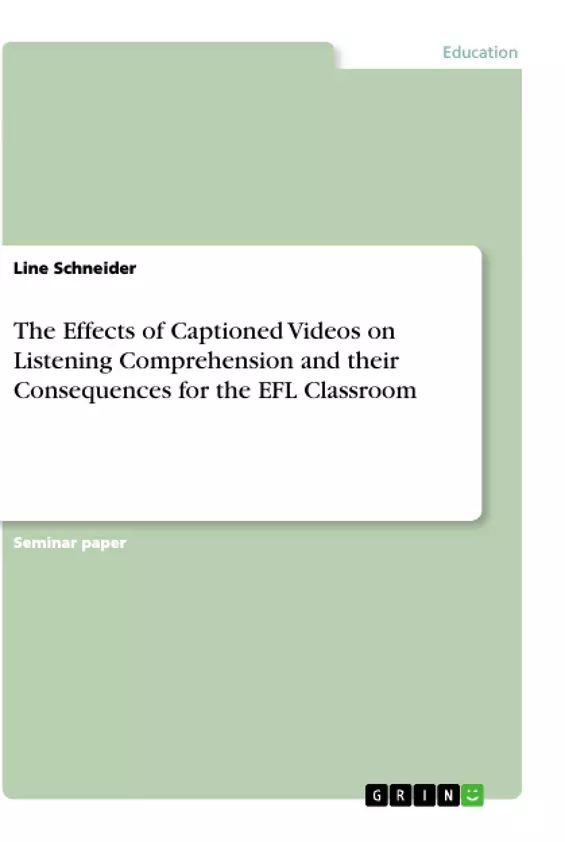Firstly, this work will elaborate on the importance of listening comprehension and refer to further paralinguistic features that are required to understand video material. Furthermore, it will give reasons to incorporate videos in the EFL (English as a foreign language) classroom. In the analytic part of this paper, it will deal with the contradictory findings of some selected studies on captioned videos. It will additionally elaborate different approaches and suggestions for foreign language teachers and their teaching.
In recent years, the media have developed rapidly and in many ways. In the same way, there have been many changes in foreign language teaching. From voice recordings, radios to videos, the way teaching is organized has changed and is changing constantly. Ever since excerpts from a radio recording and voice recordings were introduced into foreign language teaching, they have been carefully selected by teachers and embedded, for example, in a task or exercise; learners listened attentively to the audio and tried to solve the task set.
But how do you proceed with a video, which offers a visual and an auditive form of representation? Despite much research and knowledge, some questions about the relatively new medium of video remain unanswered. One of these questions is the usefulness of captioned videos.
Inhaltsverzeichnis (Table of Contents)
- INTRODUCTION.
- LISTENING COMPETENCE AND PARALINGUISTIC FEATURES
- LISTENING COMPREHENSION....
- PARALINGUISTIC FEATURES..
- REASONS TO INCORPORATE VIDEOS INTO THE EFL CLASSROOM........
- STUDY AND LITERATURE REVIEW.
- PROPOSALS FOR WORKING WITH CAPTIONED VIDEOS.
- CONCLUSION
Zielsetzung und Themenschwerpunkte (Objectives and Key Themes)
This paper investigates the effects of captioned videos on listening comprehension and their implications for teaching English as a foreign language (EFL). It explores the role of listening comprehension and paralinguistic features in understanding video materials, while presenting compelling arguments for integrating videos into EFL classrooms. The analysis delves into the contradictory findings of existing research on captioned videos and proposes various approaches for EFL educators.
- The importance of listening comprehension and paralinguistic features for understanding video materials.
- The benefits of incorporating videos into the EFL classroom for enhancing student motivation and language learning.
- Contradictory findings from existing research on the effectiveness of captioned videos.
- Recommendations and suggestions for EFL teachers on utilizing captioned videos in their teaching practices.
- The distinction between captions and subtitles in the context of video learning.
Zusammenfassung der Kapitel (Chapter Summaries)
- Introduction: The introduction presents the paper's focus on the impact of captioned videos on listening comprehension and its relevance to EFL teaching. It emphasizes the need to address the influence of video technology in education, particularly within the EFL classroom.
- Listening Competence and Paralinguistic Features: This section delves into the crucial role of listening comprehension in EFL learning, highlighting its importance alongside reading and writing skills. It discusses the active nature of listening in a second language, emphasizing the need for learners to develop skills in interpreting phonemes, stress, and intonation. Additionally, it introduces paralinguistic features such as facial expressions, eye contact, and kinesics, which contribute significantly to video comprehension.
- Reasons to Incorporate Videos into the EFL Classroom: This chapter explores the advantages of integrating videos into EFL classrooms. It highlights the motivational and enriching aspects of using videos, arguing that they provide authentic language input and opportunities for engaging and diverse learning activities. It underscores the growing popularity of videos in education and their potential to foster communicative skills.
Schlüsselwörter (Keywords)
This paper focuses on the impact of captioned videos on listening comprehension and its implications for English as a foreign language (EFL) education. Key themes include listening comprehension, paralinguistic features, video learning, EFL pedagogy, and the utilization of technology in the classroom. The analysis delves into contradictory findings from studies on captioned videos and proposes pedagogical approaches for EFL educators. This paper aims to contribute to the understanding of the complex relationship between captioned videos, listening comprehension, and EFL learning.
- Quote paper
- Line Schneider (Author), 2020, The Effects of Captioned Videos on Listening Comprehension and their Consequences for the EFL Classroom, Munich, GRIN Verlag, https://www.grin.com/document/591329



